Pradeep Thakur's Blog, page 3
December 25, 2010
The Most Important People of the 20th Century (Part-III): Builders & Titans
View this Author's Spotlight
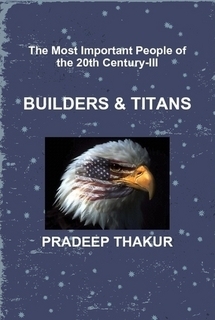
The 20th century saw a major shift in the way that vast numbers of people lived, as a result of changes in politics, ideology, economics, society, culture, science, technology, and medicine. It is essential to know the most important persons and the events of the 20th Century, which are directly impacting us. So the new book-series: The Most Important People of the 20th Century is before you. Five books of the series cover a total of 100 people, with 20 each in five broad categories. Part-I covered 20-Leaders & Revolutionaries. Part-II is devoted to the 20- Artists & Entertainers. And now the Part-III of the book-series is focused to the 20-Builders & Titans: Stephen Bechtel, Leo Burnett, Willis Carrier, Walt Disney, Henry Ford, Bill Gates, Amadeo Giannini, Ray Kroc, Estee Lauder, William Levitt, Lucky Luciano, Louis B. Mayer, Charles Merrill, Akio Morita, Walter Reuther, Pete Rozelle, David Sarnoff, Juan Trippe, Sam Walton, and Thomas Watson, Jr.
Product Details
ISBN
978-1-4357-7716-3
Copyright
Pradeep Thakur (Standard Copyright License)
Edition
First
Publisher
PRADEEP THAKUR & SONS
Published
December 25, 2010
Language
English
Pages
262
Binding
Hardcover (dust-jacket)
Interior Ink
Black & white
Dimensions (inches)
6.0 wide × 9.0 tall
List Price:$39.50Price:$35.55You Save:$3.95 ( 10% )
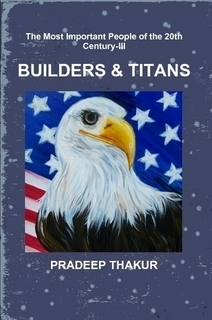
Product Details
ISBN
978-1-4357-8032-3
Copyright
Pradeep Thakur (Standard Copyright License)
Edition
First
Publisher
PRADEEP THAKUR & SONS
Published
December 26, 2010
Language
English
Pages
262
Binding
Perfect-bound Paperback
Interior Ink
Black & white
Dimensions (inches)
6.0 wide × 9.0 tall
List Price:$19.50Price:$17.55You Save:$1.95 ( 10% )
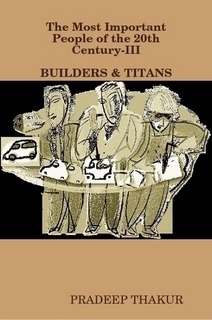
Product Details
Copyright
Pradeep Thakur (Standard Copyright License)
Edition
First
Published
December 26, 2010
Language
English
Pages
262
File Format
PDF for Adobe Digital Editions
File Size
9.7 MB
List Price:$2.99Price:$2.69You Save:$0.30 ( 10% )
CONTENTS
Preface (5-10)
Chapter-1: STEPHEN D. BECHTEL, Founder, Bechtel Corporation, USA (11-22)
Chapter-2: LEO BURNET, Advertising Executive, Leo Burnett Company, USA (23-38)
Chapter-3: WILLIS CARRIER, Inventor, Air-conditioning, USA (39-46)
Chapter-4: WALT DISNEY, American Film Producer; Co-founder, Walt Disney Company, USA (47-74)
Chapter-5: HENRY FORD, Founder, Ford Motor Company, USA (75-92)
Chapter-6: BILL GATES, Co-founder, Microsoft Corporation, USA (93-104)
Chapter-7: AMADEO GIANNINI, Founder, Bank of America (105-114)
Chapter-8: RAY KROC, Founder, McDonald's Corporation, USA (115-130)
Chapter-9: ESTEE LAUDERS, Co-founder, Estee Lauder Companies, USA (131-136)
Chapter-10: WILLIAM LEVITT, American Real-estate Developer (137-144)
Chapter-11: LUCKY LUCIANO, Italian Mobster (145-158)
Chapter-12: LOUIS B. MAYER, Ukrainian-American Film Producer (159-170)
Chapter-13: CHARLES E. MERRIL, Co-founder, Merrill Lynch & Co. USA (171-178)
Chapter-14: AKIO MORITA, Co-founder, Sony Corporation, Japan (179-194)
Chapter-15: WALTER REUTHER, American Labor Union Leader (195-202)
Chapter-16: PETE ROZELLE, American Sports Executive (203-212)
Chapter-17: DAVID SARNOFF, Chairman, Radio Corporation of America; Founder, NBC (213-224)
Chapter-18: JUAN TRIPPE, Founder, Pan American World Airways (225-238)
Chapter-19: SAM WALTON, Founder, Wal-Mart Stores, USA (239-250)
Chapter-20: THOMAS WATSON, JR., President, IBM (1952 to 1971), USA (251-262)
PREFACE
The 20th century of the Common Era began on January 1, 1901 and ended on December 31, 2000.
The British, Russian, German, Ottoman, and Austro-Hungarian empires dissolved in the first half of the century, with all but the British Empire collapsing during the course of World War I. The inter-war years saw a Great Depression cause a massive disruption to the world economy. Shortly afterwards, World War II broke out, pitting the Allied powers (chiefly the Soviet Union, the United Kingdom, the United States, and the Republic of China) against the Axis powers (chiefly Nazi Germany, the Empire of Japan, and Italy) which eventually resulted in a total victory for the Allies, at the cost of over 60 million lives and the complete devastation of many nations. As a means of preventing future world wars, the United Nations was formed; however, competition between the two new superpowers, the Soviet Union and the United States, resulted in the Cold War, which would dominate geopolitical life for the next 45 years. The Soviet Union collapsed internally in 1991, resulting in the United States taking on sole superpower status, although by the end of the century China, India, and the European Union had greatly increased their influence.
The early arms races of the 20th century escalated into a war which involved many powerful nations: World War I (1914–1918). Technological advancements changed the way war was fought, as new inventions such as machine guns, tanks, chemical weapons, grenades, and military aircraft modified tactics and strategy. After more than four years of trench warfare in western Europe, and 20 million dead, those powers who had formed the Triple Entente (France, Britain, and Russia, later replaced by the United States and joined by Italy) emerged victorious over the Triple Alliance (Germany, Austria-Hungary, and the Ottoman Empire). In addition to annexing much of the colonial possessions of the vanquished states, the Triple Entente exacted punitive restitution payments from their former foes, plunging Germany in particular into economic depression. The Russian Empire was overthrown during the conflict and transitioned into the first ever communist state, and the Austro-Hungarian and Ottoman empires were dismantled at the war's conclusion. World War I brought about the end of the royal and imperial ages of Europe, and established the United States as a major world military power.
At the beginning of the period, Britain was the world's most powerful nation; having acted as the world's policeman for the past century. Fascism, a movement which grew out of post-war angst and which accelerated during the Great Depression of the 1930s, gained momentum in Italy, Germany and Spain in the 1920s and 1930s, culminating in World War II (1939–1945), sparked by Nazi Germany's aggressive expansion at the expense of its neighbors. Meanwhile, Japan had rapidly transformed itself into a technologically advanced industrial power. Its military expansion into eastern Asia and the Pacific Ocean culminated in a surprise attack on the United States, bringing it into World War II. After having had several years of dramatic military success, Germany was defeated in 1945, having been repelled and invaded by the Soviet Union from the east and invaded from the west by the United Kingdom, the United States, Canada, and Free France. The war ended with the dropping of two atomic bombs on Japan. Japan later became a U.S. ally with a powerful economy based on consumer goods and trade. Germany was divided between the western powers and the Soviet Union; all areas recaptured by the Soviet Union (East Germany and eastward) were essentially transitioned into Soviet puppet states under communist rule. Meanwhile, Western Europe was influenced by the American Marshall Plan and made a quick economic recovery, becoming major allies of the United States under capitalist economies and relatively democratic governments.
World War II left about 60 million people dead. When the conflict ended in 1945, the United States and the Soviet Union emerged as very powerful nations. Allies during the war, they soon became hostile to one other as the competing ideologies of communism and democratic capitalism occupied Europe, divided by the Iron Curtain and the Berlin Wall. The military alliances headed by these nations (NATO in North America and western Europe; the Warsaw Pact in eastern Europe) were prepared to wage total war with each other throughout the Cold War (1947–91). The period was marked by a new arms race, and nuclear weapons were produced in the tens of thousands, sufficient to end most human life on the planet had a large-scale nuclear exchange ever occurred. The very size of the nuclear arsenal on both sides is believed by many historians to have staved off an inevitable war between the two, as the consequences of any attack were too great to bear. The policy of unleashing a massive nuclear attack, knowing a massive nuclear counterattack would be forthcoming, was known as mutually assured destruction (MAD). Although the Soviet Union and the United States never directly entered military conflict with each other, several proxy wars, such as the Korean War (1950–1953) and the Vietnam War (1957–1975), were waged as the United States implemented its worldwide "containment" policy against communism.
After World War II, most of the European-colonized world in Africa and Asia gained independence in a process of decolonization. This, and the drain of the two world wars, caused Europe to lose much of its long-held power. Meanwhile, the wars empowered several nations, including the UK, U.S., Russia, China and Japan, to exert a strong influence over many world affairs. American culture spread around the world with the advent of Hollywood, Broadway, rock and roll, pop music, fast food, big-box stores, and the hip-hop lifestyle. British culture continued to influence world culture. The western world and parts of Asia enjoyed a post-World War II economic boom. After the Soviet Union collapsed under internal pressure in 1991, the communist governments of the Eastern bloc were also dismantled, followed by rocky transitions into market economies.
Following World War II the United Nations was established as an international forum in which the world's nations could get together and discuss issues diplomatically. It has enacted resolutions on such topics as the conduct of warfare, environmental protection, international sovereignty, and human rights. Peacekeeping forces consisting of troops provided by various countries, in concert with various United Nations and other aid agencies, have helped to relieve famine, disease, and poverty, and to suppress some local armed conflicts. Europe slowly united, economically and, in some ways, politically, into what eventually became the European Union, which consisted of 15 European countries by the end of the century.
In approximately the last third of the century, concern about humankind's impact on the Earth's environment caused environmentalism to become a major citizen movement. In many countries, especially in Europe, the movement was channeled into politics partly through Green parties, though awareness of the problem permeated societies. By the end of the century, some progress had been made in cleaning up the environment though pollution continued apace. Increasing awareness of global warming began in the 1980s, commencing several decades of social and political debate.
Medical science and the Green Revolution in agriculture enabled the world's population to grow from about 1.6 billion to about 6.0 billion. This rapid population increase quickly became a major concern and directly caused or contributed to several global issues, including conflict, poverty, major environmental issues, and severe overcrowding in some areas.
The 20th century saw a major shift in the way that vast numbers of people lived, as a result of changes in politics, ideology, economics, society, culture, science, technology, and medicine.
As a journalist I am among those who observed the transition of the World into 21st century and felt the "heat and cold" of the rapid changes in every walk of the life. My generation had to fit with whole new world order. Now the present young generation is living in the era of Globalization and facing its own challenges. Both generations have less time to go through the 20th century in detail. But it is essential to know the most important persons and the events of the 20th Century, which are directly impacting us. So I decided to publish the new book-series: The Most Important People of the 20th Century.
For selection of the persons and categories, I researched a lot, but decided to follow the Time magazine list, published in December 31, 2000. The list contains a total of 100 people, with 20 each in five broad categories: Leaders & Revolutionaries, Artists & Entertainers, Builders & Titans, Scientists & Thinkers, and Heroes & Icons. Each person of this list requires the great length of writing, but that will defeat the main purpose of the series. So I felt essential to devote one whole book for each category. So, book series would be completed in total five parts.
Already published Part-I of the book-series is devoted to the 20-Leaders & Revolutionaries; and Part-II covers 20-Artists & Entertainers. The book before you: Part-III of the book-series– The Most Important People of the 20th Century– is devoted to the 20-Builders & Titans: Stephen Bechtel, Leo Burnett, Willis Carrier, Walt Disney, Henry Ford, Bill Gates, Amadeo Giannini, Ray Kroc, Estee Lauder, William Levitt, Lucky Luciano, Louis B. Mayer, Charles Merrill, Akio Morita, Walter Reuther, Pete Rozelle, David Sarnoff, Juan Trippe, Sam Walton, and Thomas Watson, Jr.
For selection of this list of 20- Builders and Titans, the Time magazine's then Editor In Chief (1995-2005) Norman Pearlstine (Chief Content Officer, Bloomberg, since June 2008) clarified in the December 7, 1998 issue of the magazine: "This issue, TIME's third in a series of five that chronicles the 100 most influential people of the century, is devoted to the 20 remarkable builders and titans who most embody capitalism and its triumphs. It also creates the occasion for this writer, who has covered business for more than three of this century's decades, to make a few observations and bestow a few honors of his own.
"From Henry Ford at one end of the century to Bill Gates at the other, these 20 people influenced lives far beyond the business world. Indeed, TIME defines the business realm broadly, including anyone who works for a living, and our list extends to the world of sports and the National Football League's Pete Rozelle, organized labor and the United Auto Workers' Walter Reuther, and even organized crime's Lucky Luciano, whose syndicate was certainly better managed than was Al Capone's.
"It is no accident that our list is almost entirely American. It does include Sony's Akio Morita, and it arguably could include a handful of other leaders from abroad, notably Japan's Soichiro Honda and Eiji Toyoda (Toyota), Italy's Giovanni Agnelli (Fiat) and Australia's Rupert Murdoch (now a U.S. citizen). But if the 20th century was…the American Century, it was largely because our system, espousing freedom of markets and freedom of the individual, rewarding talent instead of class and pedigree, bred a group of leaders whose single-minded fixation on getting rich — and creating great products in the process — led to unheard-of levels of productivity and prosperity. It was America's industrial might that enabled it to win wars and rebuild continents. Other countries may have had the capital, the natural resources or the skilled workers needed to industrialize, but their economic and political systems usually favored consensus management and faceless bureaucrats while denigrating the kind of individual initiative required to take an idea and turn it into an industry. The 21st century will no doubt include a larger number of great business leaders from outside the U.S. as more nations embrace capitalism and come to understand the importance of rewarding individual initiative."
In selecting the contents related to each personality, I have taken care of the most important facts, events and thoughts. But I went in least possible length to maintain the patience of general readers. So going through the book, you would have overall knowledge of the most important business development of the 20th century, genuinely through Builders & Titans in persons.
I have compiled and edited this book from different new sources, which are mentioned in the course of the relevant text. I am obliged and thankful to all of them, particularly the Wikipedia.
PRADEEP THAKUR
December 25, 2010








December 7, 2010
The Most Important People of the 20th Century (Part-II): Artists & Entertainers
—By Pradeep Thakur – PRADEEP THAKUR & SONS
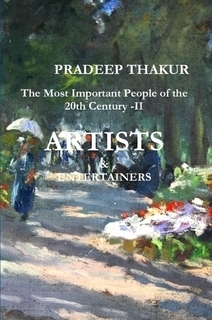
The 20th century saw a major shift in the way that vast numbers of people lived, as a result of changes in politics, ideology, economics, society, culture, science, technology, and medicine. It is essential to know the most important persons and the events of the 20th Century, which are directly impacting us. So the new book-series: The Most Important People of the 20th Century is before you. Five books of the series cover a total of 100 people, with 20 each in five broad categories. Part-I covered 20-Leaders & Revolutionaries. Now Part-II of the book-series is devoted to the 20- Artists & Entertainers: Louis Armstrong, Lucille Ball, The Beatles, Marlon Brando, Coco Chanel, Charlie Chaplin, Le Corbusier, Bob Dylan, T.S. Eliot, Aretha Franklin, Martha Graham, Jim Henson, James Joyce, Pablo Picasso, Rodgers & Hammerstein, Bart Simpson, Frank Sinatra, Steven Spielberg, Igor Stravinsky, and Oprah Winfrey.
Product Details
ISBN
978-0-557-94377-7
Copyright
Pradeep Thakur (Standard Copyright License)
Edition
First
Publisher
PRADEEP THAKUR & SONS
Published
December 7, 2010
Language
English
Pages
380
Binding
Perfect-bound Paperback
Interior Ink
Black & white
Dimensions (inches)
6.0 wide × 9.0 tall
List Price:$24.95Price:$22.46You Save:$2.49 ( 10% )








November 15, 2010
The Most Important People of the 20th Century (Part-I): Leaders & Revolutionaries
–By Pradeep Thakur – PRADEEP THAKUR & SONS
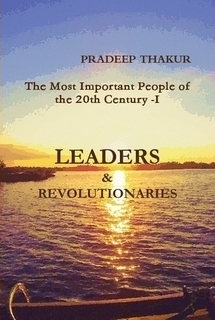
The 20th century saw a major shift in the way that vast numbers of people lived, as a result of changes in politics, ideology, economics, society, culture, science, technology, and medicine. It is essential to know the most important persons and the events of the 20th Century, which are directly impacting us. So the new book-series: The Most Important People of the 20th Century is before you. Five books of the series cover a total of 100 people, with 20 each in five broad categories: Leaders & Revolutionaries, Scientists & Thinkers, Builders & Titans, Artists & Entertainers, and Heroes & Icons. Part-I of the book-series is devoted to the 20-Leaders & Revolutionaries: David Ben-Gurion, Ho Chi Minh, Winston Churchill, Mohandas Gandhi, Mikhail Gorbachev, Adolf Hitler, Martin Luther King, Ayatullah Khomeini, V.I. Lenin, Nelson Mandela, Pope John Paul II, Ronald Reagan, Eleanor Roosevelt, Franklin D. Roosevelt, Teddy Roosevelt, Margaret Thatcher, Unknown Rebel, Margaret Sanger, Lech Walesa and MaoZedong .
Product Details
ISBN
978-0-557-77886-7
Copyright
Pradeep Thakur (Standard Copyright License)
Edition
First
Publisher
PRADEEP THAKUR & SONS
Published
November 15, 2010
Language
English
Pages
542
Binding
Hardcover (dust-jacket)
Interior Ink
Black & white
Dimensions (inches)
6.0 wide × 9.0 tall
List Price:
$49.95
Price:
$44.96
You Save:
$4.99 ( 10% )
Product Details
ISBN
978-0-557-84376-3
Copyright
Pradeep Thakur (Standard Copyright License)
Edition
First
Publisher
PRADEEP THAKUR & SONS
Published
November 15, 2010
Language
English
Pages
542
Binding
Perfect-bound Paperback
Interior Ink
Black & white
Dimensions (inches)
6.0 wide × 9.0 tall
List Price:
$34.95
Price:
$31.46
You Save:
$3.49 ( 10% )
Product Details
ISBN
978-0-557-84381-7
Copyright
Pradeep Thakur (Standard Copyright License)
Edition
First
Published
November 15, 2010
Language
English
Pages
542
File Format
PDF for Adobe Digital Editions
File Size
16.8 MB
List Price:
$6.99
Price:
$6.29
You Save:
$0.70 ( 10% )








October 28, 2010
GOLF: Career Money Leaders
–by Pradeep Thakur

In 2005, Golf Digest calculated that the countries with most golf courses per capita, starting with the best endowed were: Scotland, New Zealand, Australia, Republic of Ireland, Northern Ireland, Canada, Wales, United States, Sweden, and England. The most notable example of this phenomenon is China. The first golf course in the People's Republic of China opened in 1984, but by the end of 2009 there were roughly 600 in the country. GOLF: Career Money Leaders—features 50 top men, and 30 women, who earned highest prize money in their careers. Five introductory chapters are included to have wide view of the professional golf tours and championships. So this book is the window of the International Golf and it's most popular and highest prize money earning players.
Product Details
ISBN
978-0-557-77530-9
Copyright
Pradeep Thakur (Standard Copyright License)
Edition
First
Publisher
PRADEEP THAKUR & SONS
Published
October 28, 2010
Language
English
Pages
734
Binding
Hardcover (dust-jacket)
Interior Ink
Black & white
Dimensions (inches)
6.0 wide × 9.0 tall
List Price:
$59.50
Price:
$50.58
You Save:
$8.92 ( 15% )








October 7, 2010
TENNIS: All Time Career Money Leaders

"Tennis: All Time Career Money Leaders" features 15 men, ranked by ATP and 20 women, ranked by WTA, who earned higest prize money in their careers. The section- Men Career Money Leaders include: Roger Federer, Pete Sampras, Rafael Nadal, Andre Agassi, Boris Becker, Yevgeny Kafelnikov, Ivan Lendl, Stefan Edberg, Goran Ivanisevic, Michael Chang, Lleyton Hewitt, Andy Roddick, Novak Djokovic, Gustavo Kuerten and Jonas Bjorkman. The section- Women Career Money Leaders includes: Serena Williams, Venus Williams, Lindsay Davenport, Steffi Graf, Martina Navratilova, Justine Henin, Martina Hingis, Kim Clijsters, Arantxa Sanchez Vicario, Amelie Mauresmo, Monica Seles, Svetlana Kuznetsova, Elena Dementieva, Maria Sharapova, Conchita Martinez, Jana Novotna, Jelena Jankovic, Jennifer Capriati, Dinara Safina and Mary Pierce.
List Price:
$44.95
Price:
$40.46
You Save:
$4.49 ( 10% )
Product Details
Copyright
Pradeep Thakur (Standard Copyright License)
Edition
First
Publisher
PRADEEP THAKUR & SONS
Published
October 7, 2010
Language
English
Pages
552
Binding
Hardcover (dust-jacket)
Interior Ink
Black & white
Dimensions (inches
6.0 wide × 9.0 tall








September 24, 2010
Indian Americans (Part-I)
—-By Pradeep Thakur – PRADEEP THAKUR & SONS
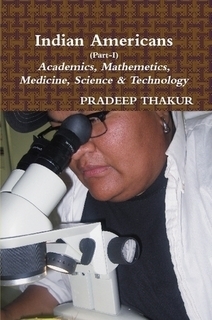
September 12, 2010
INDIAN MUSIC MASTERS OF OUR TIMES- I
By Pradeep Thakur – PRADEEP THAKUR & SONS
 Product Details
Product DetailsISBN
978-81-908705-6-6
Copyright
Pradeep Thakur (Standard Copyright License)
Edition
First
Publisher
PRADEEP THAKUR & SONS
Published
September 12, 2010
Language
English
Pages
296
Binding
Perfect-bound Paperback
Interior Ink
Black & white
Weight
1.11 lbs.
Dimensions (inches)
6.0 wide × 9.0 tall
Price:
$24.97
This is a collection of the 22 biographies of Indian musicians (Vocalists, Instrumentalist and P...
September 4, 2010
PREFACE
Tiger Woods' fall from global sports icon to tabloid fodder was stunning. He saw Accenture, AT&T and Pepsi drop him as a pitchman, but he remains the highest-paid athlete in the world thanks to huge deals with Nike, Electronic Arts and Upper Deck. Nike built a $650 million (sales) golf business from scratch on Woods' back. His fledgling golf course design business has been hurt by the economic downturn, as all three courses he's worked on have experienced major delays. But still, Tiger Woods ...
CONTENTS
Preface (vii-viii)
Brief Profile
Career records and statistics
Sports' First Billion-Dollar Man
The world's other top-earning golfers
World's top earning female golfers
Chapter-2: Background & Family (29-42)
Earl Dennison Woods: The Father
Kultida Woods: The Mother
Elin Nordegren: The Wife
Chapter-3: Glorious Golf Career (43-60)
Early amateur career (1996–98)Early Professional career (1999–2002)Domination and the Tiger Slam (1999–2002)Swing adjustments (2003–04)Resurgence...Chapter- 1 : INTRODUCTION
Brief Profile
Full name: Eldrick Tont WoodsNickname: TigerBorn: December 30, 1975 (1975-12-30)(Cypress, California)Height: 6 ft 1 in (1.85 m)Weight: 185 lb (84 kg; 13.2 st)Nationality: United StatesResidence: FloridaParents: Earl and Kultida WoodsSpouse: Elin Nordegren (married 2004)Children: Sam Alexis (June 18, 2007); Charlie Axel February 8, 2009)College: Stanford University (two years)Turned professional: 1996World Golf Ranking: 12008 earnings: $110 millionCareer prize money: $82.6...


